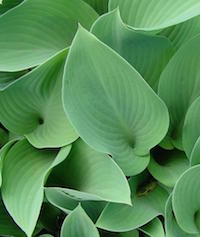Versatile and hardy, hostas are quickly becoming one of the most popular perennial plants grown in Georgia landscapes.
Sometimes referred to as plantain lilies, hostas can thrive in both shade and partial sun. Besides having wonderful foliage, many cultivars produce fragrant flowers from early summer to fall.
Available in several leaf and flower colors
Hosta's flowers are trumpet-like in shape and may be white, lavender, light blue or bicolored. Host's foliage can also be colorful, ranging from shades of yellow, green, gold to white. Some even have a blueish tint to their leaves. Variegated forms also exist. There are hundreds of hosta varieties available to homeowners today, and more varieties become available each year. Diversity in leaf color, plant shape and form make hostas excellent candidates for a wide variety of landscape situations.
Their size can range from a few inches in diameter to several feet across. They grow and spread using underground stems called rhizomes. They prefer well-drained soils amended with organic matter, such as compost or manure, and do best in raised beds. They will not tolerate soggy conditions, especially during the winter months.
To plant hostas, dig a hole as deep as the root ball and at least twice as wide as its diameter. Then backfill and water well. Space hosta plants according to their spread at maturity.
Divide in the spring
March and early spring, when a hosta’s new leaves start to emerge, are the perfect times to divide hostas, transplant them or add new hostas to your landscape. Dividing can be done either by cutting away a section of a clump with a sharp shovel or by lifting the root mass and separating it by hand. Separate the plant so that an "eye" is present in each division. Very small divisions tend to establish slowly. Most hostas can be divided in four to five years, depending on the vigor of the clumps.
Hostas are known for thriving jn the shade, but it is important to know the specific needs of each hosta variety selected. Some need more sun, while others experience leaf discoloration or leaf scorching when they don’t have enough shade.
Hostas respond best to light fertilization. Soil testing will help determine lime and fertilizer requirements. Without the benefit of a soil test, apply one-half pound of 10-10-10 fertilizer per 100 sq. ft. at planting or when growth emerges in the spring. Slow release fertilizers can also be used to meet nutrition needs throughout the growing season.
Gardeners should place mulch around hostas to help conserve moisture. Keep them moist but not wet by applying supplemental irrigation only when necessary. Hot summer days may require additional irrigation. Avoid planting hostas in areas that receive direct afternoon sun.
Pests include slugs, snails and deer
Hostas are tough plants and are otherwise healthy. Insects and diseases are seldom a problem. However, slugs and snails will devour hostas if given the opportunity. Organic controls or applications of registered insecticides are sometimes needed to control slugs and snails.
In many areas, deer may be a problem. Deer often eat hosta foliage when other food is scarce. Deer repellants may give temporary control, however, fencing or the watchful eye of the pet dog may be the only sure way to keep deer away.
For more information on growing hostas, see the University of Georgia Cooperative Extension publication "Growing Hostas" at www.caes.uga.edu/publications.







